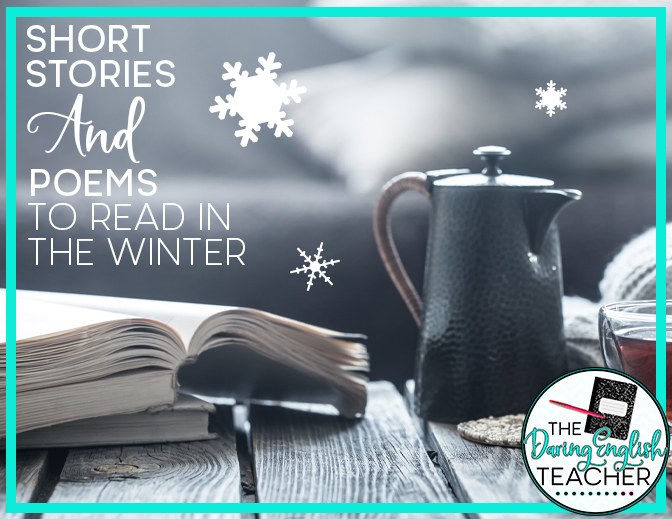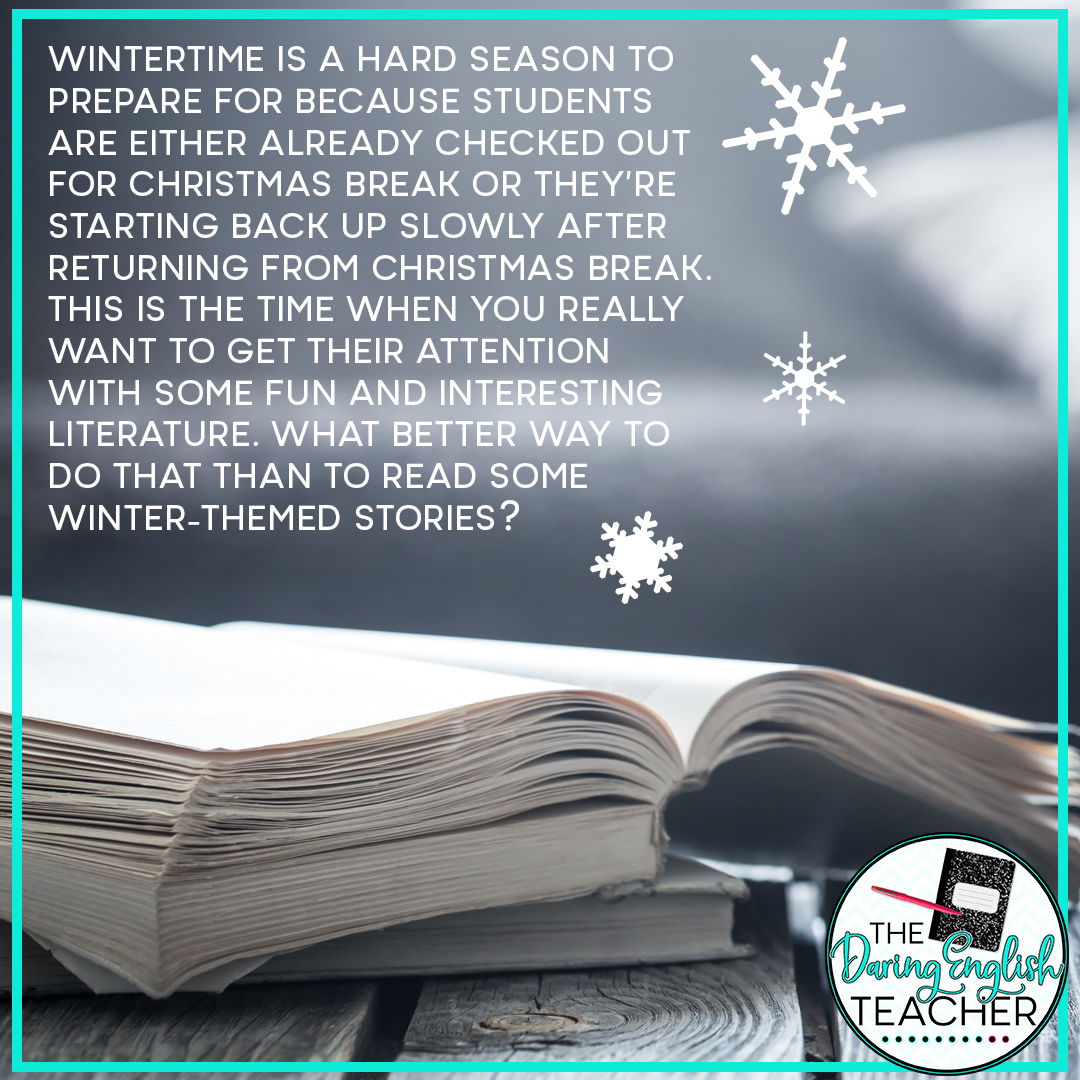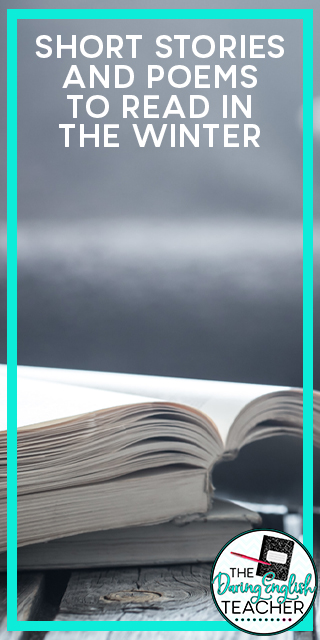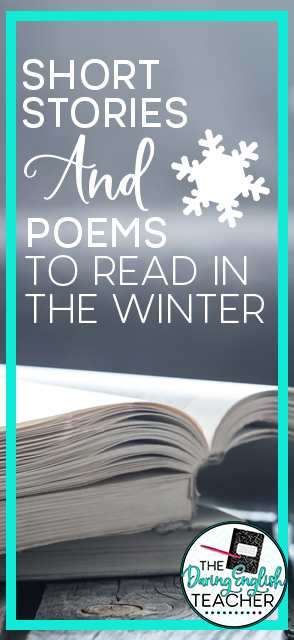Wintertime is a hard season to prepare for because students are either already checked out for Winter Break or they’re starting back up slowly after returning from Winter Break. This is the time when you really want to get their attention with some fun and exciting literature. What better way to do that than to read some winter-themed stories? The following are some short stories and poetry centered around winter that you can use to keep your students heated in those cold winter months. This post contains affiliate links.
To Build a Fire by Jack London
This classic short story will keep your students in suspense until the very end with its timeless tale of man-vs.-nature. An unnamed man in his arrogance takes on the harsh winters of the Yukon Territory and ultimately loses the fight for survival.
It sifts from Leaden Sieves by Emily Dickinson
Known for her strong imagery, Emily Dickinson paints for us a beautiful portrait of snow without ever saying the word throughout her poem. Students will benefit from learning about imagery and metaphors from one of the masters in poetry.
The Gift of the Magi by O. Henry
This is another famous short story which focuses on love and sacrifice on Christmas. It is a great story to read before Winter Break to remind students of what is most important during the holidays. Have them do an exercise to find what precious item they would give up for the one they love.
Stopping by Woods on a Snowy Evening by Robert Frost
Robert Frost is a celebrated poet who is recognized primarily for his poems about nature. “Stopping by Woods on a Snowy Evening,” even though it is a short poem, is packed with so much story. Reading this poem will get your students interested in the ways poems can open one’s imagination with only a few lines of text.
Join my email list!
Subscribe to receive updates from The Daring English Teacher.
Thank you for subscribing! You will soon receive updates, freebies, and teaching ideas.
The Blue Hotel by Stephen Crane
This fascinating short story takes a deep dive into fate and free will as we follow a group of misfortunate travelers who get stuck at a local hotel during a blizzard. One of the travelers becomes distraught because he believes someone in the hotel will kill him; and in an attempt to save himself from this imaginary threat, he instead puts himself into real danger. This is an excellent story to use to teach your students about the concept of irony and to get them motivated with an interesting mystery after coming back from break.
The Shortest Day by Susan Cooper
“The Shortest Day” written by a notable English author, Susan Cooper, is another wonderful poem to read before the break. Her poem describes the time of Yule when people come together “to drive the dark away” by celebrating Christmas and the New Year. You can use this poem as inspiration to have your students write about what they most excited for on their Winter Break.
The Adventure of the Beryl Coronet by Sir Arthur Conan Doyle
A fun story to read with your students before break comes from none other than the Master of Mystery himself. One of his many Sherlock Holmes stories where the detective must solve the mystery of who destroyed a banker’s treasured beryl coronet. Sherlock uses clues he finds in the snow to solve what looks like a closed case and finds a whole different scandal in the works. Students will have to figure out who the real culprit is, and you could give them the assignment to create their own mystery to solve.
Not Only the Eskimos by Lisel Mueller
This is a contemporary poem that takes a look at the different ways the noun snow can be used. The title of this great poem, “Not Only the Eskimos,” refers to how words in the Inuit language can have several different meanings, such as the word for “love.” Mueller labels the various kinds of “snows” we uniquely use in the English language. You can use this poem to have students widen their vocabulary and think about words with several meanings.
Gleanings from Snow Country by Yasunari Kawataba
This short story is not only interesting because of its content but also because of its origins. “Gleanings from Snow Country” is a miniaturized version Kawatabe’s Nobel Prize-winning novel, Snow Country. The story takes place at an isolated hot spring in northern Japan, where an upper-classman and lower-class woman who works as a geisha fall in love, but both know their love will never become a reality. Students will benefit from reading and discussing what is considered a classic in Japanese literature.
Winter Moon by Langston Hughes
Though “Winter Moon” is an extremely short poem, it opens up the gates for students to learn about an incredibly talented poet. This is the perfect poem for students to analyze because you can ask them what it might symbolize and mean.
The Soft-Hearted Sioux by Zitkala-Sa (aka Gertrude Simmons Bonnin)
“The Soft-Hearted Sioux” is an early 20th-century short story about a man who struggles between is Native American culture and the culture of the colonialists. During a long winter, the food runs low, and the main character must choose between his newfound Christian values of not killing and the survival of his family. This short story will open up a discussion with students about Native American, specifically Sioux, culture, and literature.
Getting Out by Elizabeth Bradfield
“Getting Out” is a contemporary freestyle poem in which Elizabeth Bradfield tells the reader about the freedom she feels when she is out on the Alaskan Range. Bradfield uses an almost conversational tone as she finds love for her self through skiing and other snow-related activities. This is a good poem to use when teaching students about more poetry styles. Students can enjoy creating their own freestyle poetry about the winter activities they enjoy.





